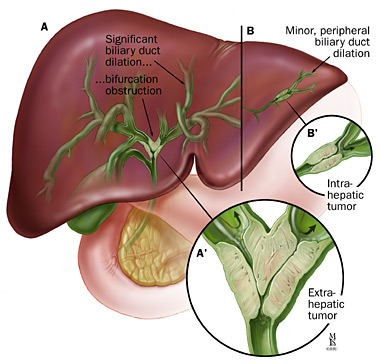Bile Duct Cancer (Cholangiocarcinoma)

Bile duct cancer is called Cholangiocarcinoma. It occurs when a malignant (cancerous) tumor grows in one of the ducts that transport bile from the liver to the small intestine.
Bile Duct Cancer Symptoms
Symptoms depend on the location of the tumor or tumors. Symptoms can include:
- Jaundice (yellowing of the skin and whites of the eyes)
- Pruritus (itching)
- Abdominal pain
- Fever
- Weight loss and/or progressive weakness
Bile Duct Cancer Diagnosis
A diagnosis of bile duct cancer begins with comprehensive physical exam during which you describe your symptoms and medical history. Other tests your doctor may perform include:
- Laboratory Tests
- Imaging Scans
- Endoscopic Diagnosis
- Percutaneous Radiological Diagnosis
Destroying the tumors is the best chance to cure bile duct cancer. Treatment often depends on the size and location of the tumors. Treatment options include:
- Surgery
- Endoscopic therapy
- Radiological therapy
- Liver transplantation
- Other treatment approaches
Bile Duct Cancer Treatment: Surgery
Surgical removal of tumors is the only treatment option that offers the potential for a cure. Surgical approaches have become increasingly more aggressive as doctors have learned that the more aggressive the surgery, the higher the chance of a cure.
Surgery for bile duct cancer involves a major liver resection. Your surgeon will remove the entire tumor. The exact procedure will depend on the location of the tumor and how advanced the disease is.